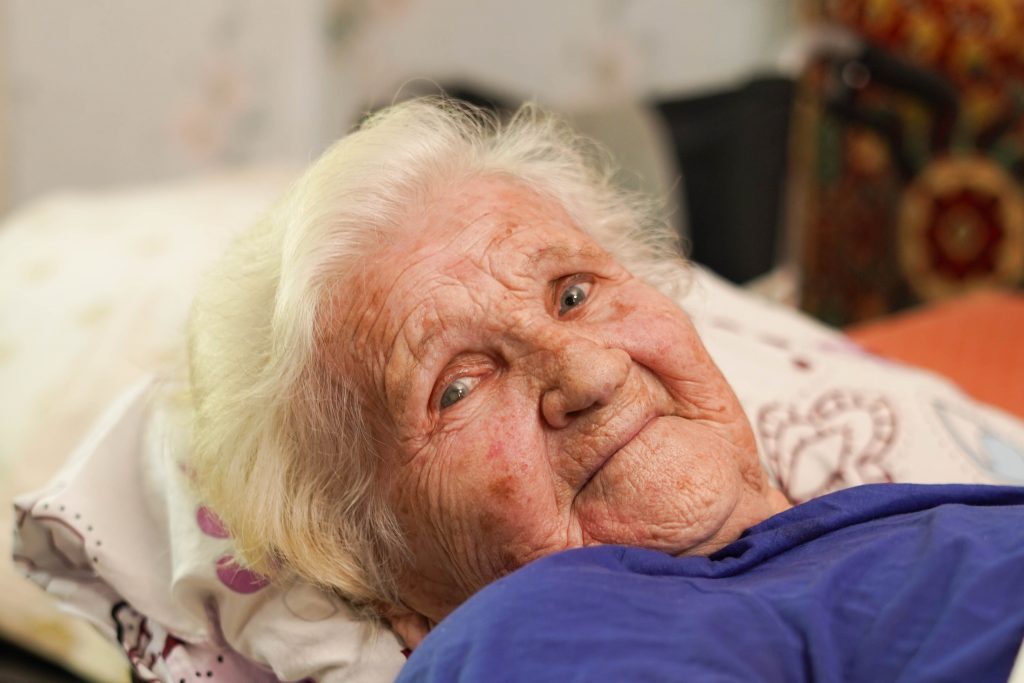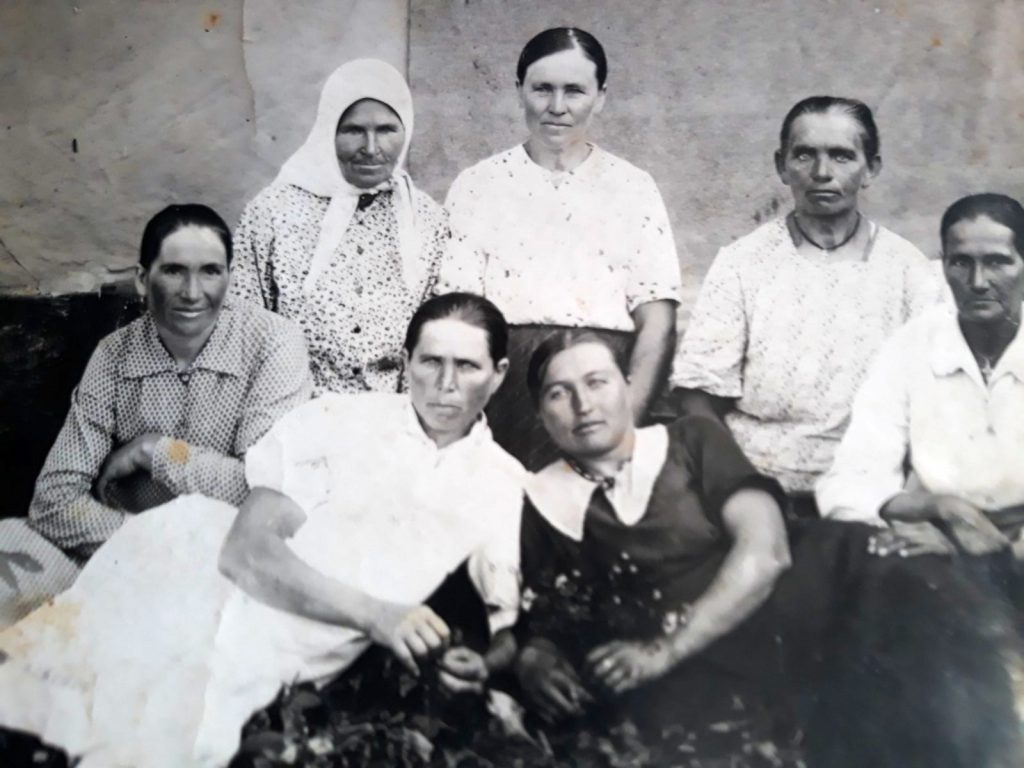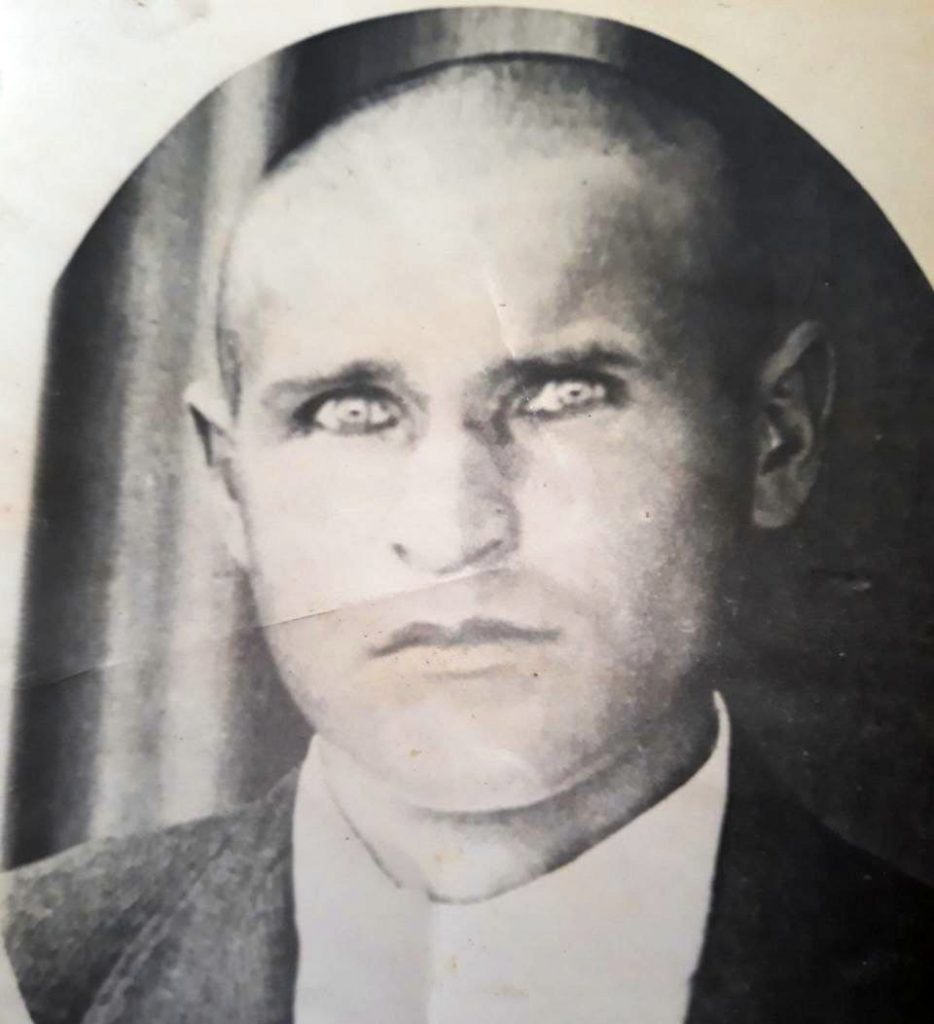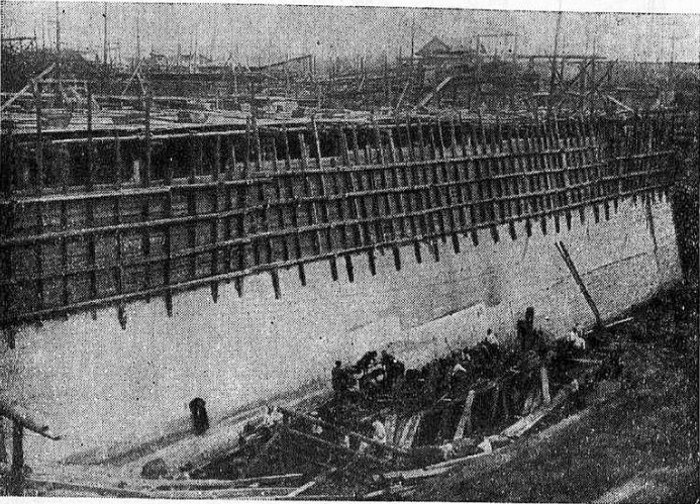How my father saved his co-villagers from starvation during the Holodomor | Voices of witnesses

Holodomor witness Pelaheia Hnativna Tovkach, born in 1928.
When she was just 5 years old, Pelaheia Tovkach became a witness of the Holodomor, the genocidal famine of the Ukrainian nation, when millions of Ukrainians were killed by starvation in less than two years. Curious from an early age, today the 93-year-old woman tells in detail and with her own assessments of those events the history of her village during its destruction by the communist totalitarian regime through the policy of collectivization, dekulakization, and the Holodomor of 1932-1933.
Pelaheia Tovkach spent her childhood in the little village of Krasnyi Yar in Kharkiv Oblast. The villages Kolomatskyi Shliakh, Nastynkivka, Serhiivka, Sukhomlynivka, Koliadivka together with Krasnyi Yar (nowadays these settlements do not exist) appeared as the farms in the early 20th century after Stolypin’s agrarian reform.
During the Soviet occupation, these villages belonged to the Kytchenkivka village council, where Pelaheia’s father worked as a secretary. He was well acquainted with the situation of the inhabitants of the whole district.
The Chahovets family before collectivization
Before collectivization, the majority of Ukrainians in the villages were grain-growers and ran individual farms. The young Chahovets family kept a relatively small farm, but they had horses and cultivated their own land, which was profitable.
“How did we live? We were not so rich but did not starve either, we lived like all ordinary people,” Pelaheia Tovkach says. The parents worked together on the farm to support the family, “The father goes to the field early in the morning to cultivate the land, and he takes the mother to drive the mare.”
Her mom Marfa became an orphan early and did not receive significant wealth from her parents, but she was taught to work hard from a very young age. Pelaheia’s father Hnat, although coming from an ordinary family, was an educated man, he studied and successfully graduated from the church-parish school,
“My father was, how to say it, he graduated from the parish school with a letter of commendation. They were such poor people then, but he graduated, and he was literate. Well, he lived so quietly somehow, he was a smart man, he behaved himself well, and people respected him, and he respected people.”
After their property was confiscated, some peasants lost their minds and committed suicide
The family learned about the future forced collectivization from the press, where the regime ran active propaganda for a new type of agricultural organization—collective farms or kolkhozes.
This prospect did not please the Ukrainian farmer at all. A few years before, Ukrainian grain-growers had quickly developed mutually beneficial cooperation during the NEP period. . Ukrainian landowners were a real threat to the communist totalitarian regime and its total control over economic life.
The lines from the newspaper, which his son read aloud, frightened the Chahovets’ grandfather, but they prepared the family in advance for the “reforms” that were soon introduced by the Soviets. Unfortunately, Ukrainians did not then fully understand that the regime would not take into account any human rights. Under the slogans of building a happy society, it created devastation and violence: “How can they take away my oak forest? I bought it, this can’t be real!”
The grandfather did not live to see overall collectivization, so he did not know how his sons were deprived both of their oak forest and a new house built of the same oaks.
Land, horses, oxen, cows, and agricultural equipment were taken to the collective farms, and people had to go to work every day. There were cases when the owners lost their sanity after the confiscation of their farm and committed suicide. Collectivization process did not omit the Krasnyi Yar village.
“We had a mare and a cart and harness. Well, dad, he was the owner, then he had something. And then they started to take everything away. People are crying, they take away horses, take away harnesses, take away carts. Everything had to be taken to the collective farm.”
Hnat Chahovets felt sorry for the horses, but he understood the hopelessness of his situation. He asked his wife to take the cattle to the collective farm, because he could not dare to do so. Due to the negligence of the first collective farmers and the illiteracy of the leadership sent from the city, the cattle at the collective farm were neglected and hungry. The owners often returned the cattle home. Chahovets’ wife did so when she heard that her fellow villagers were rescuing their horses.
Forced collectivization led to various forms of resistance. One of them was to slaughter and sell the cattle, despite instructions to hand over everything to the collective farm. For example, to not give away a fattened calf, Pelaheia’s father and his neighbor slaughtered the animal and took the meat to Kharkiv, where they successfully sold it. The father returned from the city with bread bought with the money he earned — it was already 1932.
The regime suppressed the resistance of Ukrainians by force and intimidation. In the late 1920s and early 1930s, the Ukrainian SSR became a country of weeping and fear, a country where human dignity was neglected. After the fatal year of 1933, one could observe horrible pictures of forced labor of Ukrainians exhausted from hunger on the collective farms:
“They drove us to work […] in 1934, it was already spring, we have to do it, to plant everything. They drove us to work, and people were so weak, they couldn’t do anything, but they went, they went to work.”
In particular, in 1933 there was a shortage of labor to conduct a sowing campaign, and it was common practice to attract students and workers from the city.
“They came here, there was Bilobrova, I remember Bilobrova, there were some engineers, well, workers, they helped us. Well, they didn’t help there for long — just for a week or two and that was it,” Pelaheia Tovkach says.

Residents of the village of Krasnyi Yar together with Chahovets Marfa Kuzmivna (bottom row, the first one from the left). Photo from the early 1950s.
Grains and potatoes were buried under paths and in the walls of wells
Since the communist totalitarian regime adopted and implemented more than 80 resolutions and executed the personal orders of Stalin and his immediate entourage in 1932-1933, a mechanism of physical extermination of the Ukrainian nation was launched by creating conditions incompatible with life.
Ukrainians used every opportunity to save themselves and their children from starvation. They shared what they managed to hide with their neighbors and relatives, and if a cow remained on the farm, milk became the main source of survival for a large family. The Chahovets family also had one cow left, which they kept in the house so that it would not be stolen or slaughtered by hungry fellow villagers. Under the influence of hunger, people committed such thefts.
Prudent Ukrainians, already realizing the intentions of the communist regime to confiscate bread to the last grain, made hiding places with wheat, beans, potatoes, and so on. If the hidden provision was not found during the searches, it was a chance to escape starvation.
“They buried, buried things along the paths where people walk. They buried and walked there, so nobody knew. And then they choose an hour to dig the things up. And people hid food in the wells, too. […] There is water in the well, the wood at the top and at the bottom, but it is empty inside. And they lower someone, he digs here and there and takes a bag of grain. And he will take only a scoop, a small scoop for the family, because if there had been anything left, they would come, see it and say, ‘Where did it come from?’ But this way they never found it anywhere.”
The large and tightly-knit Chahovets family, which lived near each other in the same village, showed mutual assistance and support during the genocide:
“They helped us, everyone helped us. Someone had a few potatoes left, another one had beets, another one had something else.”
Pelaheia recalls that once her mother’s godfather from the village of Kachalivka came to them and asked for help.
“She fed him and poured him some milk to bring home. And he left, well, after a while he did not get home— he died. He was hungry, he ate something and died on the road,” the woman says.
Hunger depleted his body so much that after long-term starvation food consumption led to rapid death.
The source of survival for children was also the nursery at the collective farm, where food was organized for the smallest. Children were fed balanda or grout, and on best days they received kulish. Pelaheia used to go to the nursery with her two-year-old sister Katrusia. The children received poor nutrition, but it was better than no food at home. She remembered eating cherry leaves, and soft edible shoots of some grasses and trees the most. Such “food” became the usual diet for most Ukrainians in 1932-1933.
The lazybones and drunkards joined the “activists” and “Komsomol members”
In the autumn of 1932, so-called “towing brigades” were organized to carry out the grain procurement plan. Among the villagers, members of the brigade were called “activists” or “Komsomol members.” They were usually lazy and drunkards, people who had no respect among fellow villagers. Such a group was led by an authorized party member from the district.
The district authorities asked to conduct searches and confiscate everything edible. Searches were carried out more than once, this work continued even in the winter of 1933. Pelaheia Tovkach mentions the clear implementation of district instructions by a local “Komsomol member.” Her neighbors tried to hide the last food by putting their young son on a scoop with beans, but a brigade member chased the child away and took the hidden food. The brigade members did not pass by the tub with cheese, which the family had prepared since the summer:
“And then they had such a tub for cheese, such a small tub, from the summer they prepared cheese, while the cow was milking, they prepared cheese. The cheese was made and pressed there and filled with water to soak. So it froze, and they were beating it, but could do nothing, because it froze. And it remained, they did not take it. Well, they had nothing else to take away. All the grain was taken in autumn.”
Shops for trading with foreigners purchased jewelry and family heirlooms for nothing
During the Holodomor, there was a system of shops of Torgsin (short for Russian “torgovlya s inostrantsami,” “trade with foreigners”), which bought gold and silver earrings, crosses, rings, and other products made of precious metals from the population for nothing. Watches, awards, utensils, and coins of old mintage — all this was also taken to reception points. Exhausted by continuous starvation, people had to hand over family heirlooms to get a piece of bread or other food.
Parents gave their food to their children and died themselves
Pelaheia Tovkach recalls that many parents died of starvation, giving food to their children in the first place.
“Here, in the second house from ours, three children were left, and on the other side of the street Skliar family lived—and there were only two children left, their parents died. Parents take whatever they find to their children, but they die themselves.”
Adults used every opportunity to save their children.
During the Holodomor, it was not uncommon to take the children to the city and leave them on the streets, at train stations, in markets, or near orphanages. That’s how the adults wanted to save three children in the Vedmydenko family from Krasnyi Yar. Their father had already died of starvation by that time, and the grandmother persuaded their mother, “Take the children to Kharkiv, take them, because they will die and we will die too.”
And she did. The woman left the children in the city, hoping that they would survive behind the walls of the orphanage. The older children were soon returned from Kharkiv and brought to the neighboring village of Kostiantynivka. However, the 2-year-old boy did not return, he went missing—it is unknown whether he managed to survive. For the rest of her life, the mother blamed herself for the forced act and the loss of her child.
During the Holodomor, there were cases of cannibalism as a result of mental disorders from long-term starvation. Pelaheia Tovkach mentions such a case in her village. Her fellow villager killed her own child after several months of starvation. Later, after eating some bread, she realized her own actions and lost her mind. The woman was driven through the village and forced to shout all over the neighborhood that she had eaten her child. People who committed such crimes under the influence of hunger, punished themselves all their lives, suffered moral torment, and were often forced to move because of the contemptuous attitude of their fellow villagers.
(Not) dekulakized. How Hnat Chahovets saved his fellow villagers as secretary of the village council
Thanks to the discovery of new archival documents and the processing of the stories of Holodomor witnesses, the list of Ukrainian righteous and saviors is supplemented every year. Among them, there are heads of collective farms, state farms, village councils, school principals, teachers, doctors, ordinary farmers, or city inhabitants, who did not forget about mutual assistance and, despite the risk of punishment, rescued fellow villagers or even strangers.
They used the slightest opportunity to help, show humanity and save someone’s life. Hnat Chahovets, working as the secretary of the village council and not having much influence on the leadership of the village of Kytchenkivka, managed to help many fellow villagers to leave their native places and seek survival outside the village.
Krasny Yar was located near Kharkiv, the then capital of the Ukrainian SSR, so the villagers, hoping for survival, looked for opportunities to get a job in the city. However, with the introduction of passports in 1932, such a chance for the villagers was sharply reduced. The “Instruction on the Issuance of Passports” did not provide documents for Ukrainian farmers. Now, when applying for a job, one had to present a document or a certificate from the village council. Dekulakized farmers became the most disenfranchised category, as they were called “kulak” and could not get a job, for a long time they were not even enrolled in the collective farms.
Hnat Chahovets showed ingenuity and managed to help dekulakized fellow villagers:
“They came for a certificate, to get a certificate, to go to Kharkiv, where there will be work. My father issued these certificates. And he wrote that the certificate is given to such and such that he was dekulakized, and he left such a space to write something else. Then the head reads that he was dekulakized, puts a seal, signs and then they give it to my father. And he takes it back and writes where he left the place, ‘Was not dekulakized.’”

Hnat Chahovets (1899–1942). Photo from the 1930s.
Hnat Chahovets issued a lot of such certificates. People were grateful to him for his help and came back to thank him even after his death during World War II.
How communists spied on their own activists and relocated Russian kolkhoz workers to Ukraine
The communist totalitarian regime was based on force and intimidation. Soviet agitation called for fighting the “enemies of the people,” the “kulaks,” and the “Petliurists,” and destroying them without pity.
However, the communists did not stop there. They went even further — they checked and wrote denunciations on their own people. Pelaheia’s father was also supervised, being suspected of hiding bread. Surveillance was conducted around the clock: a village activist was sitting in a haystack, hoping to catch the secretary red-handed to imprison him. Fortunately, the Chahovets family found out in time that they were being watched, and acted cautiously.
Hnat Chahovets was in fact imprisoned, but only after the Holodomor. Because of his kindness, he lent money to a familiar seller of a village store from the village council’s cash register, which was immediately discovered by members of the audit commission. He was ratted on and imprisoned.
“And then he was given a year in prison for embezzlement. And then he dug the Moscow-Volga canal,” the daughter recalls.
During the construction of the 128-kilometer canal, which was to connect the Moscow and Volga rivers, the labor of Gulag prisoners was used.
In 1932, a special camp Dmitrovlag was established for this purpose, which existed for more than five years. In 1933, more than 50,000 prisoners worked in forced labor, and by 1934, more than 150,000.

Construction of Moscow-Volga canal. (Source: Moscow-Volga Canal. Concrete Works. Moscow, 1941. P. 205).
After 1933, many empty houses remained in Ukrainian villages, the inhabitants of which were starved to death or fled the village in search of rescue. This was a good reason for the planned relocation of collective farmers from Russia to Ukraine, which Pelaheia Tovkach remembers well. Descendants of immigrants live in neighboring villages to this day.
Reflecting on the genocide of the Ukrainian nation, the events that took place after 1933 and the current Russian-Ukrainian war, Pelaheia Tovkach concludes, “They say that they are our brothers. No, they aren’t.”
